
The Ministry of Culture is the ministry of the Government of France in charge of national museums and the monuments historiques. Its goal is to maintain the French identity through the promotion and protection of the arts on national soil and abroad. Its budget is mainly dedicated to the management of the Archives Nationales and the regional Maisons de la culture.

Prostitution in France was legal until April 2016, but several surrounding activities were illegal, like operating a brothel, living off the avails (pimping), and paying for sex with someone under the age of 18.

Marthe Richard, née Betenfeld was a prostitute and spy. She later became a politician and worked towards the closing of brothels in France in 1946.
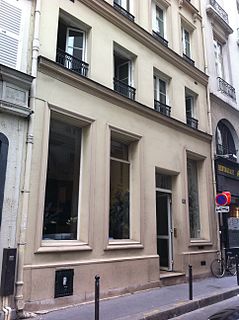
Le Chabanais was one of the best known and most luxurious brothels in Paris, operating near the Louvre at 12 rue Chabanais from 1878 until 1946, when brothels were outlawed in France. It was founded by the Irish-born Madame Kelly, who was closely acquainted with several members at the Jockey-Club de Paris. Among the habituées were Albert, Prince of Wales ; Henri de Toulouse-Lautrec; Cary Grant; Humphrey Bogart, Mae West and diplomatic guests of the French government.
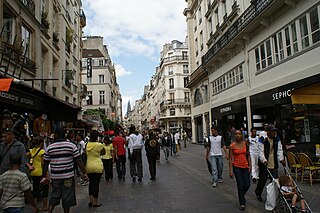
Rue Saint-Denis is one of the oldest streets in Paris. Its route was first laid out in the 1st century by the Romans, and then extended to the north in the Middle Ages. From the Middle Ages to the present day, the street has been notorious as a place of prostitution. Its name derives from it being the historic route to Saint-Denis.

Marguerite Gourdan, née Marguerite Alexandrine Ernestine Stock was a French brothel owner and procurer in 18th-century Paris. Her brothel was the most exclusive in Paris during that age, and Gourdan was arguably the most famous of her profession.
Loi Marthe Richard of April 13, 1946 abolished the regime of regulated prostitution in France that had been in force since 1804. It required the closure of brothels. The law bears the name of Marthe Richard, who was a municipal councillor of Paris but not a parliamentary representative.
Henri Joseph Thomas (1878-1972) was a Belgian genre, portrait and still life painter, sculptor and etcher from the Belgian School, Brussels, Belgium.

La Fleur blanche was a famous maison close (brothel) in the city of Paris, located at 6 rue des Moulins in the 1st Arrondissement. The property was also known as rue des Moulins and was famous for its torture room.
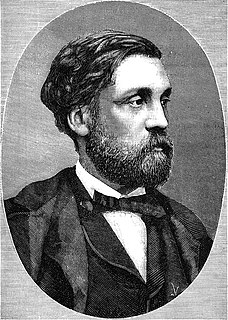
Jean Henry Blondel was a prolific French architect.

Nicole Claveloux is a French painter, illustrator and comic book artist.
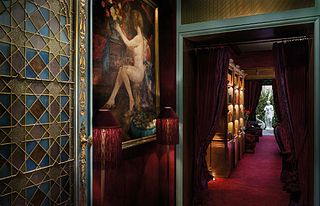
Maison Souquet is a 5-star hotel, part of Maisons Particulieres Collection, located at 10, rue de Bruxelles in Paris, on the outskirts of Montmartre. The hotel is inspired by the Parisian brothels from the Belle Époque period. Maison Souquet is decorated by the French designer Jacques Garcia.
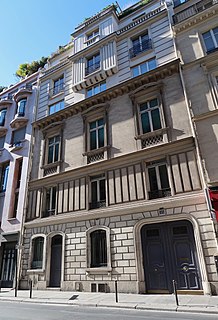
The One-Two-Two was one of the most luxurious and illustrious brothels of Paris in the 1930s and 1940s. The name was taken from the address, 122 Rue de Provence, 8th arrondissement of Paris. The numbers were translated into English to ensure that foreign tourists would be able to find the brothel and as a password for French people.
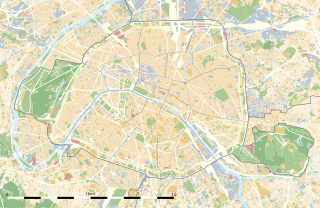
The Lanterne Verte(Fr. Green Lantern) was a brothel in Paris. It was located on the corner of Rue de Chartres and Rue de la Goutte d'Or in the Goutte d'Or district in the 18th arrondissement, and was one of the more moderate brothels of Paris. The unusual thing about this brothel was that it had no rooms. The writer and poet Sylvain Bonmariage describes it in his book Gagneuses as follows:
"The Lanterne Verte was a brothel; it was declared as such, and in its large hall, furnished as a cafe, naked girls served the offer of the house. A schoppen white wine cost a franc and who wanted to fuck with the girls or wank one, the waitress was paid forty sous. Everything happened on a bench or chair of the establishment: there were no rooms. Customers entering were usually surprised at two or three pairs who were just in full swing. This Lanterne Verte was a prosperous business; each waitress served thirty customers on average between twelve o'clock and five o'clock in the morning, which brought her sixty francs".

Le Fourcy was the most famous mass brothel of Paris, a so-called Maison d'abattage. It was located in the Saint-Paul district in the 4th arrondissement at 10 rue de Fourcy, and was notorious for treating its women very badly. In his book Le Petit Simonin, novelist Albert Simonin wrote:
"The Fourcy in the district of Saint-Paul, the most famous of the Paris slaughter houses, demanded 5.50 francs per session. "Five francs per lady and room," as if it were a chorus's chorus, who goes to the room? "The ten sous, which were asked for as a supplement to the five francs, is not a tip, but a tariff for the towel attracted so many customers on working days that some ladies who were not too bad, were anything but unemployed and able to cope with seventy sessions."
The authorities of medieval Paris attempted to confine prostitution to a particular district. Louis IX (1226–1270) designated nine streets in the Beaubourg Quartier where it would be permitted. In the early part of the 19th century, state-controlled legal brothels started to appear in several French cities. By law, they had to be run by a woman and their external appearance had to be discreet. The maisons were required to light a red lantern when they were open (from which is derived the term red-light district and the prostitutes were only permitted to leave the maisons on certain days and only if accompanied by its head. By 1810, Paris alone had 180 officially approved brothels.
Prostitution in Paris, both street prostitution and prostitution from dedicated facilities has a long history but also its own modernity in the French capital. Prostitutes are mostly women but also include transgender people and men.

The Palais Oriental, known locally as the PO, was a luxury maison close (brothel) in Reims, France. It opened in 1926 and closed in 1946, following the introduction of the Loi Marthe Richard, which abolished brothels in France. It was located on the corner of the rue de la Magdeleine and rue Bacquenoi. The prestige of the Palais Oriental rivalled that of Paris's most luxurious maison closes, the One-Two-Two and Le Chabanais.

The history of prostitution in France has similarities with the history of prostitution in other countries in Europe, namely a succession of periods of tolerance and repression, but with certain distinct features such as a relatively long period of tolerance of brothels.
















